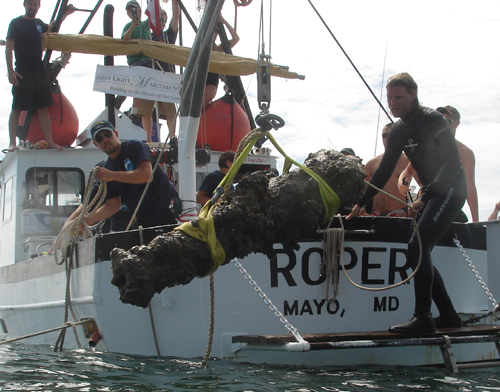
The first of two cannons successfully raised from the site of a late 18th century shipwreck offshore St. Augustine, at the close of LAMP’s archaeological field school in late June.
June 28 was the big day. The culmination of our annual archaeological field school and of a month of diving to excavate the 18th century Storm Wreck. Every day since the first week of June we’d been departing the Lighthouse for an hour trip out the inlet and south, to the location of St. Augustine’s relict inlet where so many ships came to grief in the 1700s and 1800s. Throughout the month, we’d been coordinating teams of divers, students working side by side with archaeologists from LAMP, Flinders University in South Australia, and elsewhere, to excavate sand from around ancient artifacts, including six cannon. We decided early on to raise two of these guns, in order to study a more representative sample of the three styles of cannon present on the site. But that decision was ambitious, and raising not one but two cannons is a monumental task.
And it was a task that took almost the entire month of fieldwork to pull off successfully. First an accurate grid system needed to be established, in order to record the exact location and dimensions of all artifacts, including the cannons, and to orient them spatially to the artifacts recovered during last year’s excavation, just a few meters south of the cannon pile. Divers established a PVC grid attached to lines extending beyond the excavation area, tied into the seafloor with steel screw anchors. Two teams of divers used hand-held water-powered dredges to suck sand away from the cannon area, one square meter at a time. The guns and other exposed artifacts were drawn to scale underwater, before and after excavation. Their vertical positions were recorded in addition to the bird’s eye view of the site.
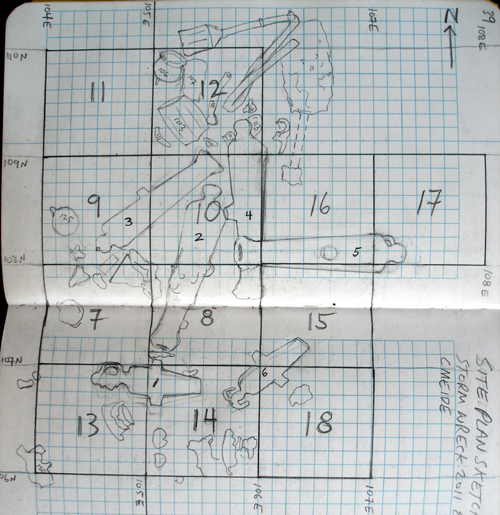
This site plan, showing the 2011 excavation area, including Units 7-18 (each a square meter) and all six cannons, was drawn in the primary LAMP field notebook and is based on scaled drawings completed underwater.
There were five cannons partially exposed before excavations began, and these were designated Cannons 1 through 5, and marked underwater with zip ties in a way that divers could identify them even in total darkness. A sixth cannon was discovered when excavating in Unit 14, and a new grid square (Unit 18) was established so that divers could expose its entire length as well. All six cannons were documented by student divers recording a specific set of measurement using cannon recording forms printed on waterproof paper (mylar), as seen here:
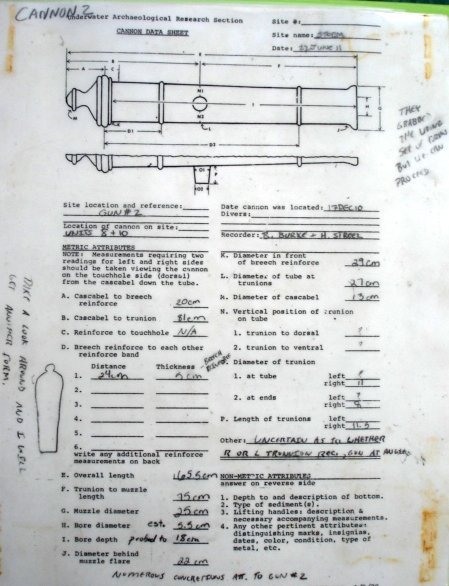
The recording form used to document the specific dimensions of Cannon 2, which was the larger of the two eventually raised by LAMP archaeologists.
This exercise, completed only two days before the scheduled lifting, finally allowed us to understand the form of each gun. We had three specific styles of guns. There was a matching pair (Cannon 1 and 6) of what appear to be carronades, which are short, lighter guns which fire relatively large shot though for a limited range. Carronades were introduced during the last quarter of the 1700s. Then there were three traditional long guns (Cannons 2, 4, and 5), each measuring approximately 5 feet, 5 inches in length. Finally there was a single gun, Cannon 3, which was a long gun but was actually shorter in length than the other three. One of our interns, a former high school student LAMP volunteer and now a freshman engineering major at Georgia Tech, designed an excel spreadsheet to estimate the weight of each gun based on a series of key measurements recorded by our divers.
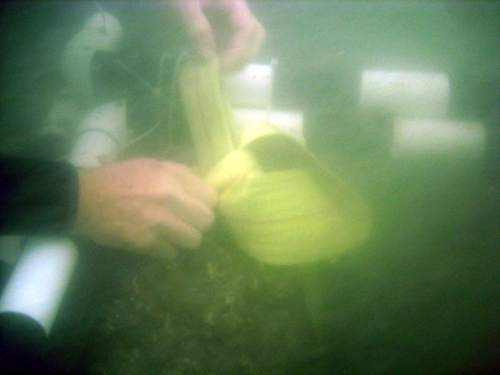
LAMP diver attaching lifting straps to one of the two guns chosen for raising.
Once we knew the shape and size of each gun we made our decision on which guns to raise. We originally intended to raise one of the two carronades and one of the matching long guns. After strapping Cannon 1, we made a last minute change and decided to pull up Cannon 6 instead, which meant switching out the straps underwater. Factors that played a role in deciding which guns to raise included logistical (which guns would be the simplest to raise, which were isolated from surrounding artifacts, which were not positioned under other guns), conservation-oriented (were there other objects attached to the guns which would require immediate electrolysis), and research oriented (which guns seemed to promise the most useful information). Cannon 6, which was the last to be discovered, only days before the lift, featured a very interesting curved handle arrangement on its cascabel, like nothing that any of our team had seen before. Once we exposed this, we decided that Cannon 1 seemed to have had a similar arrangement, but that it’s handle was broken or damaged, so the call was made to recover the better-preserved example of this unique artifact. This had an additional benefit; Cannon 1 was right next to an extremely fragile copper kettle, or rather two kettles nested together, which would have to be recovered before that gun could have been lifted. We didn’t want to rush this potentially delicate operation, and Cannon 6 was located a safe distance away from this and other artifacts.
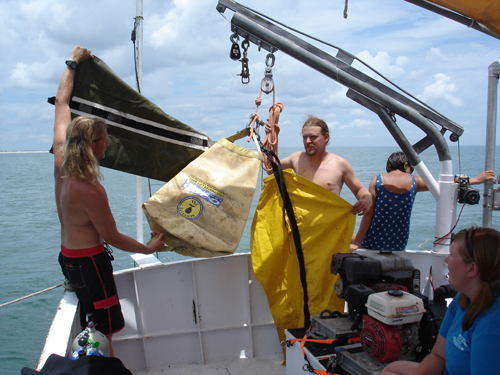
The newly installed lifting davit on the stern of RV Roper. LAMP Director Chuck Meide, at left, and LAMP Archaeologist/Logistical Coordinator Brendan Burke, right, are using it to inspect the three lift bags that will be used the following day to help raise the cannons. The two lift bags on the left were provided by IMH, each with a capacity of 200 lbs of underwater lift. The larger bag on the right, with 500 lbs of underwater lift capacity, was donated to LAMP several years ago by the respected underwater archaeologist Dr. David Switzer of Plymouth State University.
So the day before the planned lift, we had decided on raising Cannon 2 and Cannon 6. Both were rigged with a pair of lifting straps. We were planning on using our own vessel, the RV Roper on loan to LAMP from the Institute of Maritime History, to make the lift. The Roper had recently had a heavy lifting davit installed, just for this purpose. Despite the davit’s size, its capacity was close to our estimated weight threshold for our heavier gun. I have been directly involved in the raising of four cannons in my career before these two, and each time our project either owned a large crane (on the Belle cofferdam) or had use of a massive barge and crane for the lift (in both cases donated by a local marine construction company). Each of these cases involved a lot of overkill, a lifting system that could easily handle the weight of the gun. In our case, the Roper‘s lifting system was theoretically enough for the job, but it was near its upper capacity. In order to make this work, we’d need lift bags attached to the guns underwater, to lighten the load for our davit and winch during the ascent to the surface, and then a quick re-rig using block and tackle to handle the weight out of the water, up and onto the Roper‘s deck. The amount of cable we could fit on the winch was an important consideration, as was the distance between the davit and the bottom of each attached cannon (this distance had to be shorter than the distance from the davit to the Roper‘s transom, in order to swing the raised gun inside the boat. And of course we had to know without a shadow of doubt the physical weight capacity of the davit, the winch, the winch cable, and the various shackles and pulleys required for the lift. And we had to have some wiggle room, since we didn’t have a way to precisely estimate cannon weight, despite our volumetric calculations, since each gun was encased in concretion which masked its original dimensions, and whose weight was impossible to predict with any accuracy.
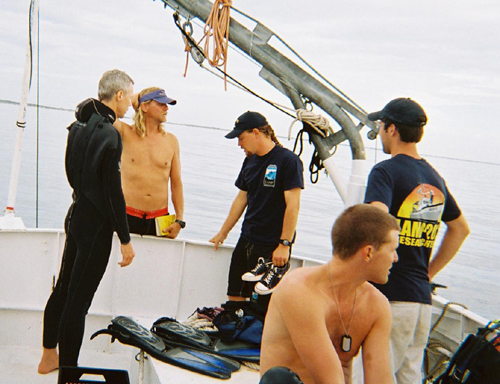
LAMP Director of Archaeology Dr. Sam Turner (far left), LAMP Director Chuck Meide (center left), and LAMP Logistical Coordinator Brendan Burke (center) have a quick planning session before sending divers in to perform a variety of tasks required before the lift can commence. LAMP Field School Supervisor and Georgia Tech student Mike Jasper (far right) watches while LAMP Field School Supervisor and recent Flinders University masters graduate Matt Hanks (foreground) prepares for his dive.
The morning of the lift we woke up earlier than usual, meeting at 0530 instead of our usual 0600. Believe it or not, I was interviewed at that ungodly hour by a TV news crew from Channel 4, as my crew assembled gear on the boat behind me in the dark hour before sunrise. Once on site, there was a lot of work to do. I sent three teams of divers down each with a variety of tasks. Speed was of the essence, we had a lot to do before a small flotilla of press, Lighthouse staff and Board members, LAMP students and volunteers, and museum supporters arrived on site for the scheduled lifting. Before then, we had to remove the PVC and line grid system so that the cannons could be lifted straight up, but do so in a way that would allow us to re-install the grid in its exact location. Disassembling 12 grids and repositioning lines criss-crossing the site was quite a task, but our team was well-coordinated and after a month of excavation they are used to performing complicated tasks at my command. Another team made necessary adjustments to the straps on the two targeted guns, and another was sent to record a few key elevation measurements that we wanted to get before removing the guns. And of course, after an entire month of relatively good visibility, we suddenly had black water conditions which hampered our diver’s sight. But after honing their skills for a month, we have developed a really competent team, and they handled these tasks with ease.
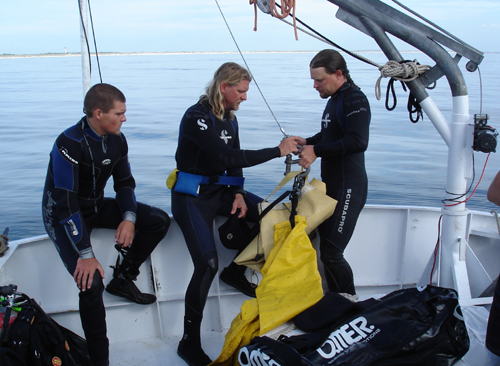
A last minute planning session was orchestrated by LAMP Logistical Coordinator Brendan Burke, at right, along with LAMP Field School Supervisor Pat McGovern (left) and LAMP Director Chuck Meide (center). After this last-minute run-through, Pat and Chuck dived to first attach the lifting cable to the strapped cannon below, and then to attach and inflate the lift bags to assist the Roper‘s lifting davit.
When all of these tasks were completed, it was time for the last dive on Cannon 2 while it was still on the sea floor. Chuck and Pat dived to attach the lifting cable, and also lift bags, to this gun. In the dark this was a complicated operation: just finding the correct gun was a challenge, let alone dealing with shackles and cables and three different lift bags. The entire time I was worried about the possibility that this gun was concreted or stuck to the bottom, and that our davit wouldn’t be strong enough to break this bond and raise the gun. But once there was 900 lbs of lift from the three lift bags attached to the cannon, it began to move! We had overestimated the weight of this long gun by at least 100 lbs, and its underwater weight was less than 900 lbs. So I removed one of the two 200 lbs lift bags, and it became stationary on the seafloor again.
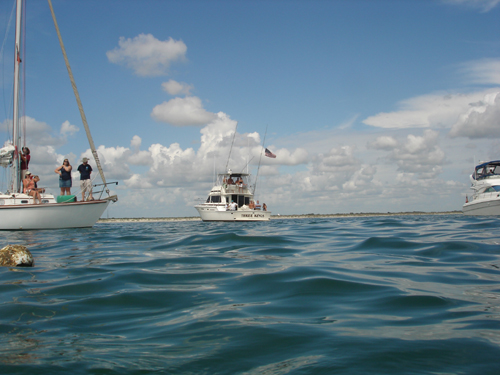
At the prescribed time, a fleet of spectator boats arrived and hovered around the triple-anchored Roper for a front-row seat to the cannon raising.
When Pat and I surfaced, the flotilla had already arrived. The lift was on! It was slow at first, and everyone waited breathlessly while the mechanical wince scraped and grinded its cable up from the seafloor.
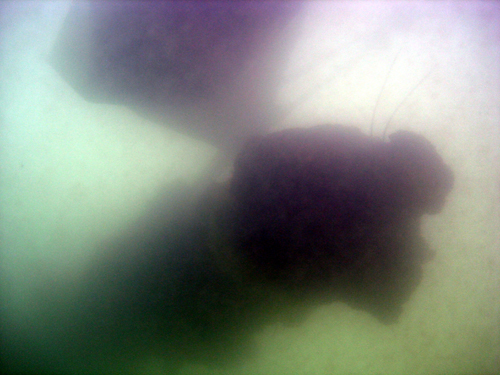
An underwater photograph of the cannon attached to lift bags as it ascends to the surface.
Once the lift bags just break the surface, the lift is halted. A diver proceeds to tie a heavy line from the boat to the lifting shackle.
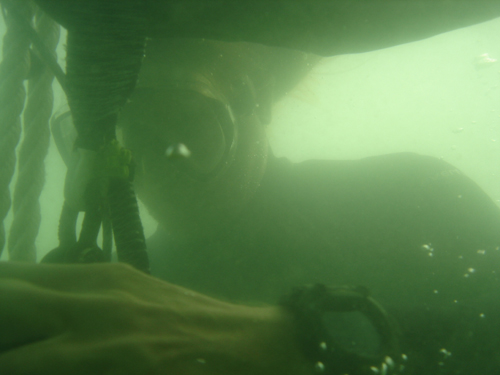
Chuck adjusting the rigging of the cannon as it dangles beneath the boat.
Now the gun’s full weight is being held by one of Roper‘s stern cleats, and the lifting cable can be removed from the gun, and re-rigged through a more complex series of block and tackle. The lift bags are also removed by the diver.
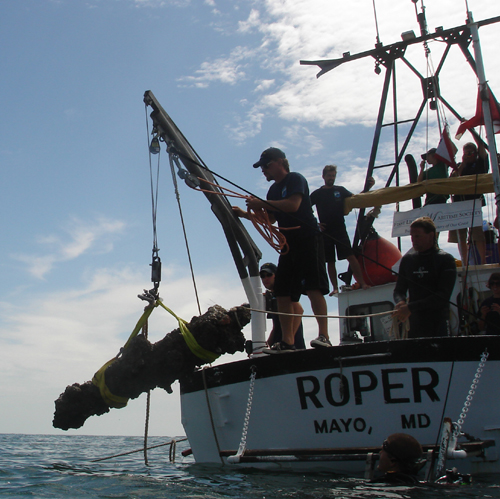
With Brendan carefully controlling the winch and davit, Cannon 2 sees the light of day for the first time in over two centuries!
At last the final leg of this journey begins. The winch slowly, slowly raises the gun the rest of the way to the surface, where its encrusted mass is touched by daylight for the first time in more than 200 years. The entire operation goes so smoothly, you’d think that we raise cannons every day!
Here is video of the raising of the first gun:

